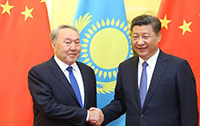Insight: The greening of China's power supply
(Xinhua) Updated: 2015-11-29 18:34BEIJING - Having set ambitious climate-change goals in advance of the upcoming Paris conference, China is powering up clean energy sources to fuel the economy.
In the small town of Niuzhuang, Shandong Province, electricity and biogas generated by Lyu Ligang's straw digesting plant are heating the local community this winter. Unlike megalithic thermal power plants, Lyu's small operation will not add to the Shandong smog.
"There is almost zero pollution in the process," Lyu said. Chopped straw is burned to produce steam that drives electrical turbines. Alternatively, straw is loaded into an anaerobic digester that produces methane which can be used directly for heating purposes.
Operating at full capacity, the plant can generate 7 GWh of electricity each year -- enough power for more than 5,000 average Chinese households -- plus 3 million cubic meters of methane. All this is done by merely disposing of agricultural waste cleanly. The plant produces 4,000 tonnes of carbon dioxide less that a coal-fueled plant.
"Fossil fuels lead to heavy pollution and the resources are shrinking. Clean energy is the long-term option," Lyu said.
As Lyu contemplates the expansion of his clean energy business, 3,000 km west in Xinjiang, giant wind turbines rotate against a bright blue sky and solar panels shimmer under the winter sun.
The vast inland region boasts 3,400 hours of sunshine a year and has 37 percent of the country's wind energy. It is China's clean energy heartland with a combined capacity of solar and wind power totaling 14.43 GW as of November, almost 30 percent up from last year.
The region has transferred around 3.8 TWh of clean electricity to other parts of China since 2010, mainly to satisfy the enormous needs of east coast metropolises.
In Toksun County, an area subject to continuous gales, Trina Solar opened a 90-MW PV plant this year, the largest in Xinjiang. Plant manager Ye Weiguo estimates the plant can generate 118 GWh a year, slashing carbon emissions by 100,000 tonnes compared with thermal power.
From straw burners in small villages to vast plains covered in solar panels, new energy projects are appearing at an unprecedented pace.
After over three decades of vertiginous expansion, China has secured its place as the world's second-largest economy and is narrowing the gap with the United States.
However, this speeding locomotive still bears a greater resemblance to a steam engine than a bullet train, running mainly on inefficient, dirty fuel. Around 70 percent of China's energy still comes from cheap, polluting coal.
"We must rethink energy policy in the face of energy security problems, climate change and various environmental challenges," said Nur Bekri, head of the National Energy Administration. "The future of the world's major energy sources is green and low-carbon."
China's latest five-year development plan promises an energy revolution. Better technology and non-fossil fuels mean that biomass, geothermal, hydro-, solar and wind power must do the heavy lifting.
"Turning to clean energy is inevitable. The sacrifice of the environment can not continue," said Wang Wei of North China Electric Power University.
Hydro projects are speeding up; tax breaks and subsidies offered to new energy companies, and the results have been satisfactory. The world's largest energy consumer and producer is leading the world in PV production, wind and hydropower.
Having poured 89 billion US dollars into clean energy, China scored 2.29 on a 0-5 scale in last year's Climatescope clean energy survey, the highest among 55 nations surveyed, said an independent industry report.
China brought around 35 GW of renewable power generation online last year, more than that of US, Britain and France combined, according to the report.
"China continues to play a critical role in clean energy evolution, not just in emerging markets but in all countries," said the Climatescope report.
The proportion of non-fossil fuels in China's primary energy consumption has reached 11.2 percent, up from 6.8 percent from 10 years ago. The government promises the ratio will rise to about 20 percent by 2030.
In China's Intended Nationally Determined Contribution, submitted to the UN, the nation agrees that, before 2030, it will cut carbon emissions per unit of GDP by 60 percent to 65 percent from 2005 level.
President Xi Jinping will attend the opening ceremony the Paris climate change conference from Nov. 29 to 30.
The conference is the latest attempt by world leaders to reduce carbon emissions through a legally binding treaty since the 2009 Copenhagen talks failed to deliver a deal.
China hopes that "a powerful, ambitious and legally binding deal" can be reached in Paris, said Xie Zhenhua, China's special representative on climate change.




